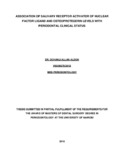| dc.contributor.author | Ochanji, Allan A | |
| dc.date.accessioned | 2017-01-09T12:01:02Z | |
| dc.date.available | 2017-01-09T12:01:02Z | |
| dc.date.issued | 2016 | |
| dc.identifier.uri | http://hdl.handle.net/11295/99969 | |
| dc.description.abstract | Introduction
Periodontal diseases are some of the commonest oral health problems. They affect every race worldwide and their prevalence varies from region to region. An important aspect of tissue breakdown in these diseases is alveolar bone loss. However, the mechanisms that lead to the bone loss are not well understood. Increasing evidence has shown that resorption of bone is regulated by two biomarkers - receptor activator of nuclear factor ligand (RANKL) and osteoprotegerin (OPG).
Aim: To determine the association of salivary levels of the bone remodelling regulators RANKL and OPG with periodontal clinical status.
Materials and Methods: This was a descriptive cross sectional study and was carried out at the University of Nairobi Dental Hospital.158 participants were selected from a pool of adult patients who visited the dental hospital during the period of study via systematic random sampling method. Saliva was collected from each participant followed by periodontal clinical examination.
Saliva collection: About 5 mL of saliva was collected from each participant (unstimulated whole saliva).Collection was done between 7 and 9 am through expectoration and transferred to the lab for immediate centrifugation. The supernatant was collected and aliquoted in 500 μL using micropipettes into a clean microcap tubes prior to freezing at -70°C until processing.
Clinical evaluation: Periodontal examination of all teeth was done at six points and included pocket depths, gingival recession and clinical attachment loss. Other clinical parameters included plaque score and gingival index.
Biomarker analysis: Concentrations of RANKL and OPG was determined using human RANKL and OPG enzyme linked immunosorbent assay (ELISA) kits as per the manufacturer’s instructions. The results were expressed as picograms per milliliter (pg/mL). The laboratory stage of the study was performed at the Kenya AIDS Vaccine
xiv
Initiative (KAVI) - Institute of Clinical Research, College of Health Sciences, University of Nairobi.
Data analysis: Coding, entry and analysis was done by Statistical Packages for Social Sciences (SPSS) 20 for windows. Categorical data were presented in frequencies and percentages. Continuous data was presented in mean, median, range and standard deviation. Association between a categorical variable (e.g. gingival index, CAL) and a continuous variable (e.g. RANKL, OPG level) was tested through t-test and ANOVA. The independence of the association was analyzed by ordinal hierarchical multiple linear progression, adjusting for age and smoking habit.
Results: A total of 158 participants were included in the study with 92 (58.2%) being females while 66 (41.8%) being males and age range of 18-75 years. Of the 158, 9 were extreme outliers hence excluded at the analysis stage. RANKL had a mean salivary level of 14.65 pg/mL (+ 18.72SD) and strong level of association with the severity of periodontal disease (F = 64.82, p < 0.001) where higher levels were detected in severe grades of the disease. The mean OPG levels in the saliva samples ranged from 4.33 to 204.33pg/mL with a mean of 139.03 pg/mL (+ 51.19 SD). The mean levels were significantly high in cases without periodontitis or in cases with milder grade of periodontitis (F =19.031, p<0.001). Consequently, a strong positive correlation was established between RANKL/OPG ratio and the severity of periodontal disease ((rs = 0.759, p< 0.001).
Conclusion
The levels of RANKL and OPG in saliva and their relative ratio have strong association with the severity of periodontal disease.
Recommendation
Salivary levels of RANKL and OPG and their relative ratio should be considered as a potential adjunctive diagnostic tool for evaluating periodontal disease. However, there is need for more salivary proteomic studies and randomized controlled trials in Kenyan setting to fully exploit the potential application in periodontal diagnosis. | en_US |
| dc.language.iso | en | en_US |
| dc.publisher | University Of Nairobi | en_US |
| dc.rights | Attribution-NonCommercial-NoDerivs 3.0 United States | * |
| dc.rights.uri | http://creativecommons.org/licenses/by-nc-nd/3.0/us/ | * |
| dc.subject | Periodontal Clinical Status | en_US |
| dc.title | Association Of Salivary Receptor Activator Of Nuclear Factor Ligand And Osteoprotegerin Levels With Periodontal Clinical Status | en_US |
| dc.type | Thesis | en_US |
| dc.description.department | a
Department of Psychiatry, University of Nairobi, ; bDepartment of Mental Health, School of Medicine,
Moi University, Eldoret, Kenya | |


